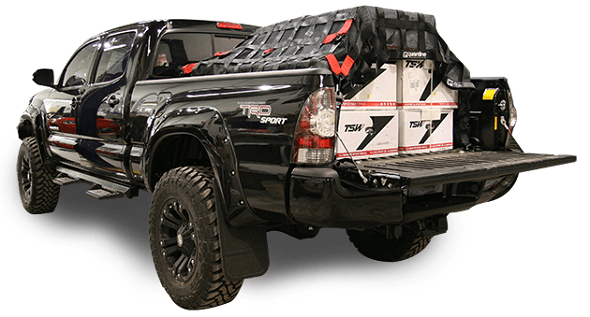Properly securing cargo is an important topic to review for all truck drivers, not just big rig operators. In fact, commercial drivers are often more equipped and better trained on how to effectively secure cargo than pickup truck drivers. “Although material does become dislodged from these (large commercial) vehicles, there are also pickup trucks and flatbeds that are hauling debris, and (those drivers) are not necessarily being as in tune as the (larger) truck drivers are.” (Business Fleet, 2013). According to AAA, poorly secured loads are responsible for more than 25,000 crashes in the United States every year. To help avoid being a part of that statistic, it’s important to review proper safety protocol for securing your cargo when traveling.
Explore these 5 ways to effectively transport your items, below:
1. Avoid Using Bungee Cords and Rope
Unlike bungee cords, ratchet straps are specifically rated for various weights and workloads. Although bungee cords may work well for securing smaller, lighter items, they’re simply not ideal for tying down most materials in the back of your truck bed.
Sure, rope and bungee cords work fine if you drive slowly and don’t hit any bumps or get into an accident. But in the real world, you have to be prepared to swerve or come to an emergency stop without ejecting your cargo. That’s precisely when rope, bungees, and twine fail. (Family Handy Man, 2018).
Instead, consider a heavy-duty ratchet strap instead. Ratchet straps that are 1-1/4 in. or wider are ideal. Be sure to store them properly to protect them from things such as moisture and sunlight.
Remember, it’s much smarter to be safe than sorry! If an item flies out of your truck while you’re driving, you’re responsible for the damage caused to other vehicles. According to the National Highway Traffic Safety Association (NHTSA), approximately 440 fatalities were caused by roadway debris in 2010.
2. Properly Balance Your Cargo Loa
It’s important that the items in your truck bed are well balanced to avoid them from becoming loose as you’re transporting them. Here are a few simple tips from Business Fleet to ensure you’re doing this correctly:
- Ensure that your cargo is placed as close to the axles of your vehicle as possible, which takes advantage of the vehicle frame strength.
- Hauling lighter and heavier items together? Consider keeping the heavier objects on the bottom and securing the lighter items on top.
- When transporting materials that extend higher than the top of your truck cab, be sure to consider the resulting wind resistance and add additional points for securement.
Additionally, Business Fleet suggests checking the weight of the anchor points on your truck. “Many pickup trucks come with various anchor points for attaching straps, but if they’re not included, there are aftermarket D rings or tie-down anchor points for pickup trucks.”
When it comes to securing your cargo, there are numerous options. From twine and sand bags (not ideal choices) to ratchet straps and cargo nets. Learn more about which tools will work best for your needs, next.
3. Research the Right Tool for the Job
 Cargo nets: ideal for securing lighter items, cargo nets are rated to the weight of the load. They are one of the most effective ways to keep items from escaping your truck bed, according to the Cargo Transportation Safety Organization. They ensure items like tarps, garage bags, and green materials like leaves don’t fly out and obstruct the view of fellow drivers.
Cargo nets: ideal for securing lighter items, cargo nets are rated to the weight of the load. They are one of the most effective ways to keep items from escaping your truck bed, according to the Cargo Transportation Safety Organization. They ensure items like tarps, garage bags, and green materials like leaves don’t fly out and obstruct the view of fellow drivers.
Cargo bars: a simple, versatile way to keep objects from sliding around in your vehicle. Effective tools for pickup trucks, station wagons and more. These tools come with easy-to-use ratcheting adjustments and can extend from 40 in. to 70 in. to fit your vehicle, according to Harbor Freight.
Ratchet straps: the working load limit for most ratchet straps is one-third of their breaking strength. However, to play it even safer, Business Fleet recommends using straps with a “cumulative load limit equal to half the weight of the load.” For example, an item weighing 300lbs should have tie downs that are rated for at least 150lbs.
Summary
Understanding how to properly secure the cargo in your truck can prevent your items from being ruined and avoid potentially serious accidents from occurring if objects fly out of your vehicle. Furthermore, every state within the U.S. has laws pertaining to unsecured loads. “All 50 states and the District of Columbia reported having fines or penalties for violating unsecured load statutes ranging from $10 to $5,000, and fifteen states add the possibility of imprisonment” (United States Government Accountability Office, 2012). By understanding the ineffective tools to avoid and researching the right tool for the job, you’ll be securing your cargo more effectively in no time.
Sources: Business Fleet, Family Handy Man, AAA, National Highway Traffic Safety Association (NHTSA), United States Government Accountability Office